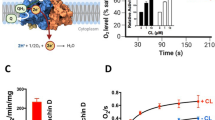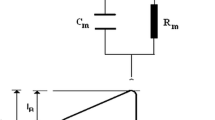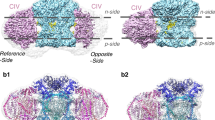Abstract
Cardiolipin (CL) is found in inner mitochondrial membranes and the plasma membrane of aerobic prokaryotes. CL is tightly bound to those transmembrane enzymes associated with oxidative phosphorylation. CL has earlier been reported to have a single pK at low pH. We have titrated CL in aqueous suspension (bilayers) and in solution in methanol/water (1∶1, vol/vol) and found it to display two different pK values, pK1 at 2.8 and pK2 initially at 7.5 but shifting upwards to 9.5 as the titration proceeds. The unusually high pK2 might be explained by the formation of a unique hydrogen bond in which the free hydroxyl on the central glycerol forms a cyclic intramolecular hydrogen-bonded structure with one protonated phosphate (P-OH group). We have therefore chemically synthesized the 2′-deoxycardiolipin analogue, which lacks the central free hydroxyl group, and measured its pH-dissociation behavior by potentiometric titration, under the same conditions as those for CL. The absence of the hydroxyl group changes the titration dramatically so that the deoxy analogue displays two closely spaced low pK values (pK1=1.8; pK2=4.0). The anomalous titration behavior of the second dissociation constant of CL may be attributed to the participation of the central glycerol OH group in stabilizing the formation of a cyclic hydrogen-bonded monoprotonated form of CL, which may function as a reservoir of protons at relatively high pH. This function may have an important bearing on proton pumping in biological membranes.
Similar content being viewed by others
Abbreviations
- BH:
-
beef heart
- CL:
-
cardiolipin (diphosphatidylglycerol)
- CL-BH:
-
cardiolipin from beef heart
- 18∶0-CL (H2-CL-BH):
-
hydrogenated beef heart cardiolipin
- H2-CL-EC:
-
hydrogenated cardiolipin fromE. coli
- cy-17∶0 andcy-19∶0:
-
9,10-methylenehexadecanoic and octadecanoic acid, respectively
- DAG:
-
diacylglycerols
- dCL:
-
2′-deoxycardiolipin (diphosphatidyl-1,3-propanediol)
- 16∶0-dCL:
-
synthetic deoxycardiolipin with palmitoyl (16∶0) as acyl groups
- DPG:
-
dipalmitoylglycerol
- DPPA:
-
dipalmitoyl phosphatidic acid
- FAB-MS:
-
fast-atom bombardment mass spectrometry
- FTIR:
-
Fourier transform infrared spectroscopy
- GLC:
-
gas-liquid chromatography
- NMR:
-
nuclear magnetic resonance
- PA:
-
phosphatidic acid
- PPD:
-
phosphatidylpropanediol
- PPOP:
-
phosphatidylpropanediolphosphate
- TLC:
-
thin-layer chromatography
References
Wasserman, A., Neisser, A., and Bruck, C. (1906)Dt. Med. Wschr. 32, 745–746.
Browning, C.H., Cruickshank, T., and Gilmour, W. (1911)J. Path. Bact. 15, 361–362.
Noguchi, H. (1911)Z. Immunitäsforsch. Exp. Therap. 9, 715–720.
Pangborn, M. (1942)J. Biol. Chem. 143, 247–256.
Pangborn, M. (1947)J. Biol. Chem. 168, 351–361.
Faure, M., and Maréchal, J. (1962)Compt. Rend. Acad. Sc. Paris 256, 4518–4520.
Gray, G.M., and MacFarlane, M.G. (1958)Biochem. J. 70, 409–425.
Benson, A.A., and Strickland, E.H. (1960)Biochim. Biophys. Acta 41, 328–333.
Le Cocq, J., and Ballou, C.E. (1964)Biochemistry 3, 976–980.
de Haas, G.H., Bonsen, P.P.M., and van Deenen, L.L.M. (1966)Biochim. Biophys. Acta 116, 114–124.
Few, A.V., Gilby, A.R., and Seaman, G.V.F. (1960)Biochim. Biophys. Acta 38, 130–136.
Coulon-Morelec, M.J., Faure, M., and Maréchal, J. (1962)Bull. Soc. Chim. Biol. 44, 171–183.
Seddon, J.M., Kaye, R.D., and Marsh, D. (1983)Biochim. Biophys. Acta 734, 347–352.
Cable, M.B., Jacobus, J., and Powell, G.L. (1978)Proc. Natl. Acad. Sci. USA 75, 1227–1231.
Powell, G.L., and Jacobus, J. (1974)Biochemistry 13, 4024–4026.
Marsh, D. (1990)Handbook of Lipid Bilayers, p. 85, CRC Press, Boca Raton.
Luzatti, V., and Chapman, D. (1968)Biological Membranes, Academic Press, New York.
Batenburg, A.M., Hibbeln, J.C.L., Vekleij, A.J., and de Kruijff, B. (1987)Biochim. Biophys. Acta 903, 155–165.
Rose, H.G. (1964)Biochim. Biophys. Acta, 84, 109–113.
Courtade, S., Marinetti, G.V., and Stotz, E. (1967)Biochim. Biophys. Acta 137, 121–134.
Hübner, W., Mantsch, H., and Kates, M. (1991)Biochim. Biophys. Acta 1066, 166–174.
Daum, G. (1985)Biochim. Biophys. Acta 822, 1–42.
Robinson, N.C., Zborowski, J., and Talbert, L.H. (1990)Biochemistry 29, 8962–8969.
Eble, K.S., Coleman, W.B., Hantgan, R.R., and Cunningham, C.C. (1990)J. Biol. Chem. 265, 19434–19440.
Horvath, L.I., Drees, M., Klingenberg, M., and Marsh, D. (1990)Biochemistry 29, 10664–10669.
Dale, M.P., and Robinson, N.C. (1988)Biochemistry 27, 8270–8275.
Kagawa, Y., Kandrach, A., and Racker, E. (1973)J. Biol. Chem. 248, 676–684.
Serrano, R., Kanner, B.J., and Racker, E. (1976)J. Biol. Chem. 251, 2453–2461.
Bligh, E.G., and Dyer, W.J. (1959)Can. J. Biochem. Physiol. 37, 911–917.
Kates, M. (1986)Techniques of Lipidology, 2nd edn, pp. 110–111, Elsevier, Amsterdam.
Harris, D.C. (1987)Quantitative Chemical Analysis, 2nd edn., W.H. Freeman and Co., New York.
Kates, M., Palameta, B., and Chan, T.H. (1966)Can. J. Biochem. 44, 707–712.
Cutler, Jr., F.A., Coubere, J.P., Lukes, R.M., Fisher, J.F., Mertel, H.E., Herschman, J., Chemerda, J.M., Sarett, L.M., and Pfister, K., III (1958)J. Am. Chem. Soc. 80, 6303–6320.
Ali, S., and Bittman, R. (1989)Chem. Phys. Lipids 50, 11–21.
Tanford, C., and Kirkwood, J.G. (1957)J. Am. Chem. Soc. 79, 5333–5339.
Haines, T.H. (1983)Proc. Natl. Acad. Sci. USA 80, 160–164.
Stewart, L.C., Kates, M., and Smith, I.C.P. (1988)Chem. Phys. Lipids 48, 177–188.
Stewart, L.C., Kates, M., Yang, P.W., and Mantsch, H.H. (1990)Biochem. Cell Biol., 68, 266–273.
Kates, M., Moldoveanu, N., and Stewart, L.C. (1993)Biochim. Biophys. Acta 1169, 46–53.
Author information
Authors and Affiliations
About this article
Cite this article
Kates, M., Syz, JY., Gosser, D. et al. pH-dissociation characteristics of cardiolipin and its 2′-deoxy analogue. Lipids 28, 877–882 (1993). https://doi.org/10.1007/BF02537494
Received:
Revised:
Accepted:
Issue Date:
DOI: https://doi.org/10.1007/BF02537494




